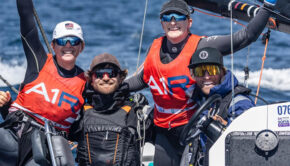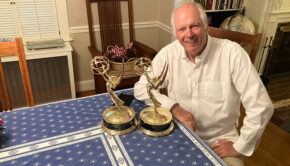When Windsurfing Was Strong in the USA
Published on October 25th, 2018
Windsurfing was born in the USA, and until class racing imploded due to an over-emphasis on extreme gear and X Games type competitions, the US sailors were as good as any. While there are signs in the US today of a comeback for windsurfing, this story revisits an era when it was strong.
At age 30, Scott Steele has been dragging his silver medal from the LA 1984 Olympics around the boardsailing course this week, trying to keep up with the next generation.
“I’m still looking for a good race,” Steele said as the 1988 U.S. Olympic trials approached their midpoint, trailing co-favorite Mike Gebhardt, 22, and two teen-age hotshots in the series.
“I would have thought that experience would help, and I’m sure it will,” the Annapolis, Md., sailor said. “My chief rival (Gebhardt) is sailing real well, (but) maybe the kids will start to falter, (although) some of them are sailing surprisingly well.”
The “kids” are products of the US Olympic Yachting Committee’s junior development program that started after Steele won his medal at Long Beach in 1984, a major breakthrough in a class dominated by Europeans.
Here, in ’88, all that earns Steele is sarcasm.
“I have a great amount of respect for Mr . Steele,” says Bert Rice Jr., waiting for a reaction, getting it, and chuckling at the ongoing joke in this mixed field of 45 competitors.
Rice, from Gulf Breeze, Fla., is the most surprising of four fast youngsters who are all 17, all cocky and all scrawny. But on a sailboard, skinny is usually fast.
After a pizza and a cola, Rice might hit 120 pounds, including his horn-rimmed glasses. At this stage of the trials he was in a second-place tie with Ted Huang of Los Alto, CA. After Rice and Huang, Mike O’Bryan, San Diego, in fifth place, and Robert Normann, Metairie, La., seventh, complete the upstart gang of four.
As in ’84, when sailboards joined the Olympics, the Americans are just hoping to be competitive with the Europeans. But they suffered a setback when the International Yacht Racing Union (now World Sailing) waited until only a year and a half ago to select the sailboard it would recommend to the International Olympic Committee for these Games.
Then the IYRU picked a Division II-type board made by the small Lechner company of West Germany, “And the Europeans gobbled ’em all up,” said Major Hall, the U.S. boardsailing coach. “We had only one winter to sail them. (It was) the same old political thing that favors the Europeans.”
The ’84 Olympics used smaller, French-made Windgliders that were unavailable to U.S. sailors until a few months before their trials.
The upside, Hall said, is that “this is a much higher performance board, plus this time we’re allowed to wear harnesses.”
The harnesses and larger boards help the smaller sailors to be more competitive in stronger winds. In ’84, Steele, then only 129 pounds, had to hope for light-wind days and got enough of them to finish second.
A downside is that the Division II boards allow a change of masts and sails according to wind and water conditions. With the Windglider, everybody sailed identical equipment.
“Not being a true one-design makes it a little confusing for me,” Steele said. “You never know if it’s you or the equipment. I just like to get on it and go.”
The sailors face this situation daily, scanning the sea from the parking lot at First Beach on the backside of Newport.
“It’s always a test,” Steele said, squinting into the haze, “like right now I’m looking at which one of four different masts I’m gonna use, and which one of two sails.”
Nearby, Gebhardt was saying, “When you start making decisions, that’s when you start getting worried.”
Rice? No problem.
“I like it when it’s more shifty and tactical,” he said. “I did a lot of my early sailing on sailboats when you had to make sail decisions and play the (wind) shifts.
“I can do it. I’ve worked 3 1/2 years for this.”
Rice, who will be 18 on Aug. 25, is enrolled at Admiral Farragut Academy in New Jersey, a prep school for the Naval Academy. It was Adm. David G. Farragut who issued the order during the Civil War battle of Mobile Bay, “Damn the torpedoes . . . full speed!”
That’s sort of how Rice feels about the veteran boardsailors.
“We’ve seen how fast they can go,” Rice said. “We’re closing the gap, but they still have a great depth of experience that we’re just touching on.”
Hall said that up to a few months ago, “We thought (the trials) might be a two-person regatta. Since ’85, Gebhardt has been in a class by himself, and Scott has come back strong after laying off for two years.
“But all of a sudden we have several people capable of winning races.”
A good problem to have.
Editor’s note: Gebi went on to win the trials and get the bronze medal at the Seoul 1998 Olympics, finishing behind kiwi Bruce Kendall and Jan Boersma of Netherlands Antilles.
Source: Rich Roberts, LA Times








 We’ll keep your information safe.
We’ll keep your information safe.